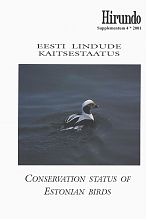Supplementum 4/2001
Conservation status of Estonian birds
Estonian Ornithological Society
Bird species of conservation concern in Estonia
Lõhmus, A.
Conservation status and conservation goals in Estonian birds of conservation concern
Abstract:The study specifies goals for bird conservation in Estonia and develops criteria for assessing the implementation of the goals. First, a theoretical overview about the viability of bird populations is given. The conservation status as well as the criteria for assessing and developing the network of protected areas are then analysed separately for (1) breeding birds, and (2) migrants and wintering species.
Lõhmus, A., Kalamees, A., Kuus, A., Kuresoo, A., Leito, A., Leivits, A., Luigujõe, L., Ojaste, I. & Volke, V.
Bird species of conservation concern in the Estonian protected areas and Important Bird Areas
Abstract: The occurrence of 136 bird species of conservation concern in the protected areas and IBAs of Estonia was analysed to find out major gaps and to improve reserve planning. For each species, the work included (1) concentrating data on the species’ occurrence and numbers by sites; (2) presenting summary statistics (numbers of occurrence sites and pairs or individuals, the best sites) for different seasons; (3) formulating conclusions about the coverage of the population by protected areas and IBAs. Altogether 134 protected areas and 53 IBAs were analysed. The mean coverage of breeding birds by protected areas was satisfactory, but differed between species. The mean coverage of staging migrants and winterers was poor. If IBAs are added to protected areas, the situation will improve a lot for migrants and winterers, but only slightly for breeders (mostly waterfowl). For filling the gaps in coverage, there is need to explore the status and distribution of 11 data deficient species, carry out bird inventories in poorly studied protected areas and potential IBAs, and to improve the coverage of forest birds. The general overview is followed by species accounts, which include summary statistics, lists of best sites, conclusions about the coverage of populations and indications of gaps.

